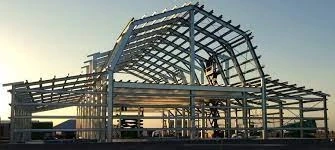Introduction:
In the ever-evolving landscape of construction, steel building have emerged as a symbol of efficiency, durability, and sustainability. From industrial warehouses to commercial spaces and even residential homes, the adoption of steel as a primary building material is reshaping the way we envision and create structures. In this exploration, we will delve into the myriad advantages and innovative applications of steel buildings that have propelled them to the forefront of modern construction.
The Advantages of Steel Buildings:
Strength and Structural Integrity:
At the core of the steel building revolution lies the unparalleled strength and structural integrity of steel. Whether it's a small storage facility or a large-scale industrial complex, steel provides the robust framework necessary to support various loads and resist external forces, ensuring the longevity of the structure.
Cost-Efficiency:
Steel buildings are renowned for their cost-effectiveness throughout their lifecycle. The speed of construction, reduced labor requirements, and minimal maintenance costs contribute to substantial savings. Additionally, steel's longevity and resistance to wear and tear make it a wise investment for those looking for a durable and economical building solution.
Design Flexibility:
One of the most compelling aspects of steel buildings is their inherent design flexibility. Architects and builders can experiment with a wide range of designs, creating structures that are not only functional but also visually appealing. The adaptability of steel allows for open floor plans, large spans, and unique architectural features that might be challenging with other construction materials.
Energy Efficiency:
Steel buildings can be designed with energy efficiency in mind. The use of insulation materials and the ability to incorporate energy-efficient systems make steel structures conducive to sustainable practices. This not only reduces environmental impact but also leads to long-term cost savings through lower energy consumption.
Applications of Steel Buildings:
Industrial Warehouses:
Steel's strength and expansive interior spaces make it the ideal choice for industrial warehouses. These buildings can house large inventories, heavy machinery, and provide the necessary space for efficient logistical operations.
Commercial Spaces:
From shopping malls to office complexes, steel buildings have become synonymous with modern commercial spaces. The ability to create expansive, column-free interiors allows for versatile use of space, accommodating the dynamic needs of businesses and tenants.
Agricultural Buildings:
The agricultural industry has also embraced steel buildings for their durability and functionality. Barns, storage facilities, and processing plants benefit from the robust nature of steel, protecting valuable equipment and crops from the elements.
Residential Homes:
Steel's entry into the residential sector is gaining momentum. Homeowners are increasingly opting for steel-framed homes due to their resistance to pests, fire, and extreme weather conditions. Additionally, the design flexibility allows for the creation of modern, aesthetically pleasing residences.
Innovations in Steel Building Technology:
Prefab and Modular Construction:
Prefabricated and modular construction methods, facilitated by steel, have revolutionized the industry. Sections of a building can be manufactured off-site, improving efficiency, reducing waste, and accelerating construction timelines.
Green Building Practices:
The green building movement has found a strong ally in steel. The recyclability of steel and the ability to create energy-efficient structures align with the principles of sustainable construction. Green roofs, solar panel integration, and rainwater harvesting are just a few examples of how steel buildings contribute to environmentally friendly practices.
Advanced Coatings and Finishes:
Continuous advancements in coatings and finishes enhance the durability and aesthetics of steel buildings. Anti-corrosion coatings, for instance, protect the steel from environmental elements, ensuring a longer lifespan and reducing maintenance requirements.
Challenges and Future Trends:
While steel buildings offer numerous advantages, challenges such as potential corrosion and the carbon footprint associated with steel production need to be addressed. Ongoing research and development are focused on creating more sustainable steel production methods and innovative building technologies to mitigate these concerns.
Conclusion:
The era of steel buildings is here, and it is reshaping the way we construct our living and working spaces. The advantages of steel - strength, cost-efficiency, design flexibility, and sustainability - position it as a key player in the future of construction. As technology and design continue to evolve, steel buildings will likely play an increasingly prominent role in creating structures that not only stand the test of time but also contribute to a more sustainable and efficient built environment. Embracing the potential of steel is not just a choice for today; it is an investment in the future of construction.


